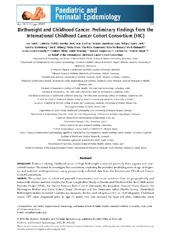Birthweight and childhood cancer: Preliminary findings from the international childhood cancer cohort consortium (I4C)
Paltiel, Ora; Tikellis, Gabriella; Linet, Martha; Golding, Jean; Lemeshow, Stanley; Phillips, Gary; Lamb, Karen; Stoltenberg, Camilla; Håberg, Siri Eldevik; Strøm, Marin; Granstrøm, Charlotta; Northstone, Kate; Klebanoff, Mark; Ponsonby, Anne-Louise; Milne, Elizabeth; Pedersen, Marie; Kogevinas, Manolis; Ha, Eunhee; Dwyer, Terence
Peer reviewed, Journal article
Published version

Åpne
Permanent lenke
https://hdl.handle.net/1956/11607Utgivelsesdato
2015-07Metadata
Vis full innførselSamlinger
Originalversjon
https://doi.org/10.1111/ppe.12193Sammendrag
Background: Evidence relating childhood cancer to high birthweight is derived primarily from registry and case–control studies. We aimed to investigate this association, exploring the potential modifying roles of age at diagnosis and maternal anthropometrics, using prospectively collected data from the International Childhood Cancer Cohort Consortium. Methods: We pooled data on infant and parental characteristics and cancer incidence from six geographically and temporally diverse member cohorts [the Avon Longitudinal Study of Parents and Children (UK), the Collaborative Perinatal Project (USA), the Danish National Birth Cohort (Denmark), the Jerusalem Perinatal Study (Israel), the Norwegian Mother and Child Cohort Study (Norway), and the Tasmanian Infant Health Survey (Australia)]. Birthweight metrics included a continuous measure, deciles, and categories (≥4.0 vs. <4.0 kilogram). Childhood cancer (377 cases diagnosed prior to age 15 years) risk was analysed by type (all sites, leukaemia, acute lymphoblastic leukaemia, and non-leukaemia) and age at diagnosis. We estimated hazard ratios (HR) and 95% confidence intervals (CI) from Cox proportional hazards models stratified by cohort. Results: A linear relationship was noted for each kilogram increment in birthweight adjusted for gender and gestational age for all cancers [HR = 1.26; 95% CI 1.02, 1.54]. Similar trends were observed for leukaemia. There were no significant interactions with maternal pre-pregnancy overweight or pregnancy weight gain. Birthweight ≥4.0 kg was associated with non-leukaemia cancer among children diagnosed at age ≥3 years [HR = 1.62; 95% CI 1.06, 2.46], but not at younger ages [HR = 0.7; 95% CI 0.45, 1.24, P for difference = 0.02]. Conclusion: Childhood cancer incidence rises with increasing birthweight. In older children, cancers other than leukaemia are particularly related to high birthweight. Maternal adiposity, currently widespread, was not demonstrated to substantially modify these associations. Common factors underlying foetal growth and carcinogenesis need to be further explored.
